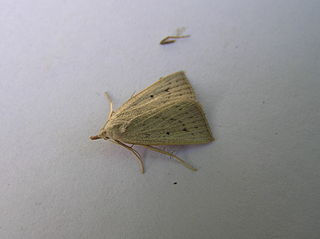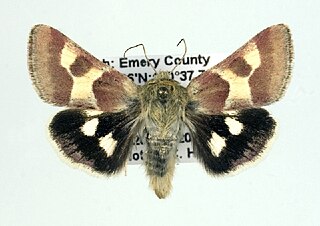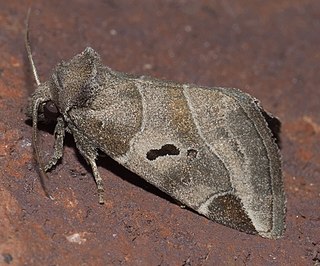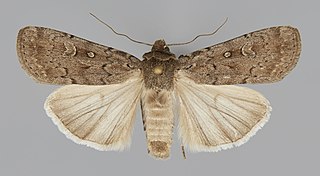
Acronicta is a genus of noctuid moths containing about 150 species distributed mainly in the temperate Holarctic, with some in adjacent subtropical regions. The genus was erected by Carl Linnaeus in his 1758 10th edition of Systema Naturae. Caterpillars of most Acronicta species are unmistakable, with brightly colored hairy spikes, and often feed quite visibly on common foliate trees. The hairy spikes may contain poison, which cause itchy, painful, swollen rash in humans on contact. The larva of the smeared dagger moth is unusually hairy even for this genus. Acronicta species are generally known as dagger moths, as most have one or more black dagger-shaped markings on their forewing uppersides. But some species have a conspicuous dark ring marking instead.

Graellsia isabellae, the Spanish moon moth, is in the silkmoth family Saturniidae. It is the only species in the monotypic genus Graellsia. The species was first described by Mariano de la Paz Graells y de la Agüera in 1849 and the genus was erected by Augustus Radcliffe Grote in 1896.
Axenus is a monotypic moth genus of the family Noctuidae. Its only species, Axenus arvalis, is found in the US states of California and Oregon. Both the genus and species were first described by Augustus Radcliffe Grote in 1873.

Chytolita is a monotypic litter moth genus of the family Erebidae erected by Augustus Radcliffe Grote in 1873. Its only species, Chytolita morbidalis, the morbid owlet moth or morbid owlet, was first described by Achille Guenée in 1854. It is found in large parts of North America, from coast to coast in the north and south to North Carolina, Texas and Florida in the west. The habitat consists of deciduous woods and edges.

Copivaleria is a monotypic moth genus of the family Noctuidae erected by Augustus Radcliffe Grote in 1883. Its only species, Copivaleria grotei, or Grote's sallow, was first described by Herbert Knowles Morrison in 1874. It is found in eastern North America, including Ontario, Tennessee, New York and Maryland.

Zanclognatha is a genus of litter moths of the family Erebidae. The genus was erected by Julius Lederer in 1857.

Isogona is a genus of moths of the family Erebidae. The genus was erected by Achille Guenée in 1852.

Hyperstrotia is a genus of moths of the family Erebidae. The genus was erected by George Hampson in 1910.

Macrochilo is a genus of litter moths of the family Erebidae. The genus was erected by Jacob Hübner in 1825.

Melanomma auricinctaria, the gold-lined melanomma moth, is the only species in the monotypic genus of moths Melanomma in the family Erebidae. It is found in the United States and Canada. Both the genus and species were first described by Augustus Radcliffe Grote in 1875.

Oxycilla is a genus of moths in the family Erebidae. The genus was erected by Augustus Radcliffe Grote in 1896.

Plusia is a genus of moths of the family Noctuidae. The genus was erected by Ferdinand Ochsenheimer in 1816.

Mellilla is a monotypic moth genus in the family Geometridae erected by Augustus Radcliffe Grote in 1873. Its only species, Mellilla xanthometata, the orangewing moth, was first described by Francis Walker in 1862. It is found in most of eastern North America.

Plataea is a genus of geometrid moths in the family Geometridae. There are about 11 described species in Plataea.

Catocala meskei, or Meske's underwing, is a moth of the family Erebidae. The species was first described by Augustus Radcliffe Grote in 1873. It is found in North America from Maine and Quebec west to southern Alberta and Montana, south to South Carolina in the east and at least Montana in the west.

Globia oblonga, the oblong sedge borer, is a moth of the family Noctuidae. The species was first described by Augustus Radcliffe Grote in 1882. It is found in parts of Canada and the United States

Schinia suetus is a moth of the family Noctuidae first described by Augustus Radcliffe Grote in 1873. It is widespread in the mountains of western North America, from southern Alberta west to British Columbia, south at least to Colorado and California, east to Idaho and New Mexico.

Spargaloma is a monotypic moth genus in the family Erebidae. Its only species is Spargaloma sexpunctata, the six-spotted gray. Both the genus and species were first described by Augustus Radcliffe Grote in 1873. It is found from coast to coast in lower Canada south in the east to Florida, Mississippi and Arkansas, in the west to California.

Stiriinae is a subfamily of owlet moths in the family Noctuidae. There are more than 20 genera and 130 described species in Stiriinae.

Actebia balanitis is a moth of the family Noctuidae first described by Augustus Radcliffe Grote in 1873. It is commonly known as the Cutworm Moth, and Bracketed Dart Moth.



















